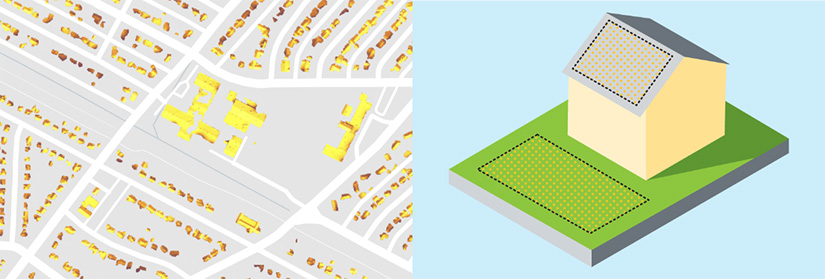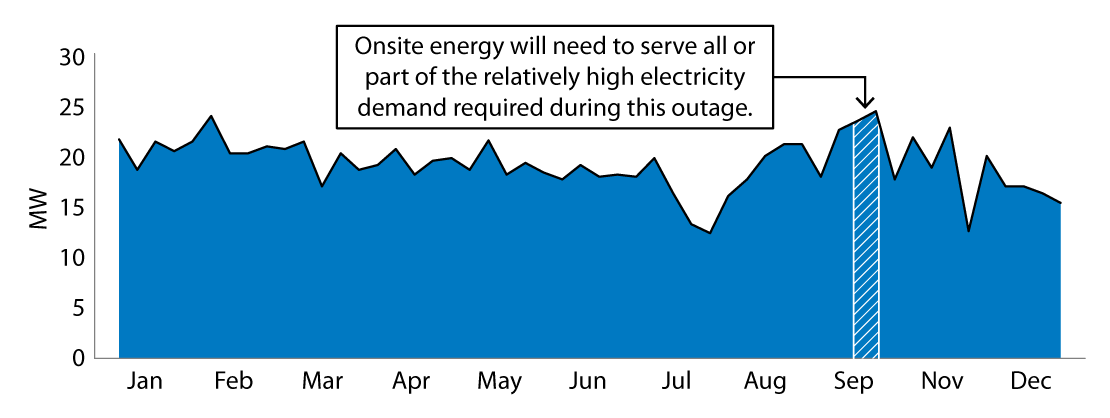Setting Energy Goals in REopt
REopt® allows users to compare multiple scenarios for their site to understand trade-offs between energy goals.
Learn one step at a time! Sign up to receive one course module each week.
Onsite energy systems can help a facility save money on energy bills, remain powered during a grid outage, or reduce greenhouse gas emissions. However, the degree to which each of these goals can be met will vary significantly depending on system characteristics. For example, a modest rooftop solar installation with a large battery may power a facility during multi-day grid outages, but the upfront cost of installing this system could exceed the bill savings it produces. Converting a facility's heating system from natural gas to electricity may allow the facility to eliminate its emissions with an onsite renewable energy system, but the facility's resilience may be reduced by the increased reliance on electricity.
REopt can evaluate systems designed to meet goals in three categories:
Sensitivity Analysis
Users can quickly adjust individual parameters and rerun REopt to see how the results change. For example, a user can run REopt for a facility with and without rooftop solar availability to understand how the optimal system is impacted by additional roof space. This is called a "sensitivity analysis" and allows users to understand how certain parameters impact their system without conducting in-depth research.
Dozens of input parameters can be adjusted in REopt to understand how changes in technologies, economics, or policy impact energy outcomes at a facility. Understanding these parameters will allow users to run multiple scenarios, compare results, and draw conclusions about potential courses of action. A handful of parameters are discussed below. To learn more about how REopt inputs can be customized to answer questions about your facility's energy goals, check out the REopt for Resilience: Assumptions and Scenarios webinar.
Cost Savings
An onsite energy system achieves cost savings when it reduces a facility's energy bills by an amount that exceeds installation, operations, and maintenance costs over the system's lifetime. REopt will always identify the system that meets a user's goals for the lowest cost, even if additional resilience and energy efficiency goals are specified.
Space Constraints
The land or roof space available for renewable installations can significantly impact the amount of energy that can be generated at a facility, thereby driving potential bill savings from an onsite system. For example, a facility may only have space available for solar panels on the roof, and the facility's roof area can be estimated using Google's Project Sunroof and input into REopt.

Net Metering
In some states, utilities account for energy generated by an onsite system by compensating the facility through customer credits. The amount of compensation a facility receives for energy exported to the grid can significantly impact the amount a facility saves on energy from an onsite system, and therefore the overall value of the system over its lifetime. The rate a facility will receive for exported electricity and other net metering policies can be found in the Database of State Incentives for Renewables & Efficiency.
Resilience
If the resilience goal is selected, REopt will optimize an onsite system to power a facility through an outage specified by the user for the lowest cost.
Outage Timing
The time of day and day of the year when an outage begins can impact the amount of energy an onsite system must generate to power a facility through the outage. For example, a facility in the southeastern U.S. may need to plan for outages during hurricane season, when energy consumption may be relatively high due to higher temperatures and an influx of tourists. REopt will optimize an onsite system according to anticipated energy loads during the hour, day, and season that an outage begins.

Outage Duration
The length of time an onsite system is required to power a site during a grid outage is the most significant driver of the size of a resilient energy system. A system designed to power a facility for 8 hours could be significantly smaller than a system designed to power a facility through a 2-week outage. Facility operators may want to plan for the most frequent outages or a worst-case scenario.
Critical Loads
A facility may not consider all functions to be necessary during a grid outage. For example, a building's heating and cooling systems could remain off during some outages without significant consequence, while lighting and machinery may need to remain powered for the facility to provide critical services. If a facility can identify a subset of electrical loads considered critical, an onsite system can be sized to serve only those loads during an outage, thereby saving upfront costs with a smaller system.
Check out this short video to explore REopt's resilience inputs in action.
Energy Efficiency
REopt considers the impacts and goals of energy systems using the latest research about current and future grid emissions, economic costs, and the health consequences of fuel emissions. There are three ways users can evaluate energy outcomes in REopt:
1. Impacts
The efficiency impacts of an onsite system are calculated in REopt by default, even
if it is not selected as a goal. These impacts include the emissions avoided
by an onsite system, the percent of a facility's energy requirements met by renewables
if the system is adopted, and the cost of emissions avoided by the system.
2. Targets
If efficiency is selected as one of the facility's goals, users can specify a renewable
energy target (percent of the facility's electricity to be met by renewables) and
an emissions reduction target (percent reduction in the facility's emissions). REopt
could recommend larger systems that are more expensive than the least-cost option
to meet these targets.
3. Costs
Researchers have estimated the climate and health costs associated with each additional
ton of greenhouse gases (carbon dioxide) and other hazardous materials (nitrogen oxides,
sulfur dioxide, and particulate matter) emitted into the atmosphere. Climate costs
estimate the economic value of climate change impacts on ecosystems, natural hazard
damages, political conflict, agricultural resources, and more. Health costs estimate
the amount to which increased emissions contribute to premature deaths. If specified
by the user, REopt will deduct these costs from the total price of the system across
its lifecycle. As a result, the net present value of the system will be higher because
the "true cost" of avoided emissions was accounted for in its design.
Here's how you change energy efficiency parameters in REopt:
Learn more about how REopt helps users consider energy goals in the REopt for Resilience webinar.
Funding an onsite energy system requires stakeholders to summarize the costs and benefits associated with the system. Systems designed to provide resilience offer benefits that can be difficult to quantify. Next week, we'll discuss the value of resilience.
Try the Next Module
Share
Last Updated Dec. 8, 2025
